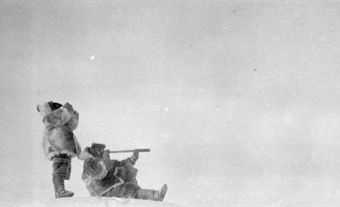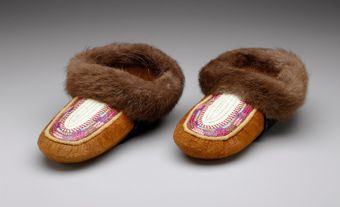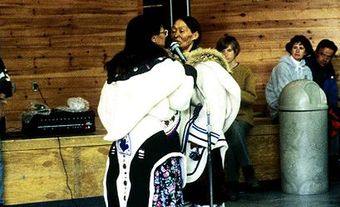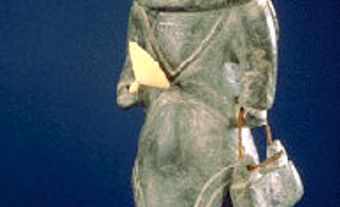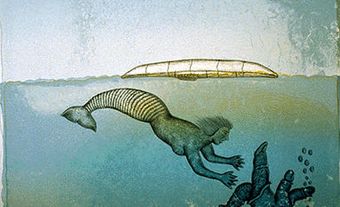Inuit authors have brought the richness and diversity of Inuit culture into the public eye with several enchanting and powerful books. From oral histories to Arctic animals to supernatural creatures, the books on this list explore various elements of the Inuit culture and way of life. Titles listed are recommended for a range of age groups, from toddlers to preteens. These books support efforts to encourage literacy, preserve and promote culture, and educate others about Inuit and Indigenous peoples and history.
1. Sweetest Kulu by Celina Kalluk, illustrated by Alexandria Neonakis (2016). Recommended for ages 0 to 3.
In this beautifully illustrated children’s book, baby Kulu is presented with gifts from various Arctic animals. For example, Arctic char gifted the newborn with tenderness, while the seal gifted creativity and colour. Written by acclaimed throat singer Celina Kalluk, this book teaches about Inuit values and about appreciation for all the land has to offer.
2. Mama, Do You Love Me? by Barbara M. Joosse, illustrated by Barbara Lavallee (1998). Recommended for ages 3 to 5.
The story begins with a little girl asking her mother how much she loves her and for how long she will love her. The girl wonders whether her mother would still love her if she misbehaved or transformed into various animals. The mother answers each query with honest expressions of her reactions and, of course, the assurance that her love is enduring and unconditional. Through conversation and colourful artwork, Inuit cultural traditions and the animals of the North are revealed and respected.
3. Bedtime in Nunatsiavut by Raeann Brown, illustrated by Raeann Brown (2022). Recommended for ages 3 to 8.
Every night, Nya’s mother tucks her into bed and they share a nose-to-nose rub — a kunik — before she drifts off to sleep. In her dreams, Nya flies, swims and wanders as she transforms into a fox, goose, salmon and more. She learns of the powers and habits of the various animals and of their roles in the natural world. Bedtime in Nunatsiavut is a gently told story based on ancient folk tales and rich with Inuit words. It suggests the interconnectedness of humans and nature, and the richness of a child’s imagination.

4. Baseball Bats for Christmas by Michael Kusugak, illustrated by Vladyana Krykorka (1990). Recommended for ages 4 to 8.
Just before Christmas in 1955, the children of Repulse Bay (now Naujaat) are confused when the bush pilot who regularly brings supplies to their remote community drops off several spindly things. They live so far above the treeline that they have never seen trees and do not know of the Christmas tree tradition. Arvaarluk and his friends conclude that they must be for making baseball bats and begin lopping off tree limbs to fashion them. The book celebrates the joys of childhood discovery and the importance of understanding cultural differences and traditions.
5. A Promise Is a Promise by Michael Kusugak and Robert Munsch, illustrated by Vladyana Krykorka (1992). Recommended for ages 4 to 7.
In this tale based on a traditional Inuit story, 10-year-old Allashua promises her parents that she will not fish in the ocean. That is where Qallupilluit live. Qallupilluit are troll-like creatures from beneath the sea ice. When Allashua disobeys her parents and goes fishing, the Qallupilluit capture her. To escape, she promises to bring her sisters and brothers to the sea ice. Her parents save the day by tricking the Qallupilluit. Allashua learns to obey her parents and always keep her promises.
6. Elisapee and Her Baby Seagull by Nancy Mike, illustrated by Charlene Chua (2017). Recommended for ages 5 to 7.
Seven-year-old Elisapee falls in love with the baby seagull that her father brings home. She names him Naujaaraq, or Nau for short. She nests Nau in a box and feeds him whale blubber and sculpins. (See also Country Food (Inuit Food) in Canada.) She later teaches Nau to fly by throwing him toward the Northern Lights. Nau grows bigger and plays with other seagulls, and one morning, the bird is gone. Elisapee learns about letting go. The story tells of the importance of caring for animals and the innocence of childhood.
7. Kamik: An Inuit Puppy Story by Donald Uluadluak, illustrated by Qin Leng (2012). Recommended for ages 6 to 8.
Based on the stories of an Inuit Elder, the book tells of young Jake, who is frustrated by Kamik, his mischievous, misbehaving puppy. Jake’s grandfather tells him about hunting and sledding with dogs and learning to rely on their strength, wisdom and courage. Jake learns about the importance of dogs in the traditional Inuit lifestyle and the trust and patience needed to properly train them. The story introduces the reader to many Inuit words and names. (See also Canadian Inuit Dog.)
8. Fishing with Grandma by Susan Avingaq and Maren Vsetula, illustrated by Charlene Chua (2016). Recommended for ages 6 to 8.
A grandmother teaches her two grandchildren how to prepare for a fishing expedition on a frozen lake. The children learn what to wear and what to bring. They travel on an ATV and learn how to test the ice for safety. They choose colourful lures and patiently jig for fish. Their work is rewarded with a feast of Arctic char. Their grandmother ensures that much of their catch is shared with others in town. The book expounds on the importance of maintaining traditional ways, sharing and respecting the wisdom of Elders.
9. The Pencil by Susan Avingaq and Maren Vsetula, illustrated by Charlene Chua (2018). Recommended for ages 6 to 8.
Susan and her sister, Rebecca, enjoy watching their mother compose letters with the family’s only pencil. While their mother is away helping a woman in a nearby igloo deliver a baby, their father gives them the pencil to play with. They draw until it grows quite small and then worry what their mother will say upon her return. The book is rich with many Inuktitut words and important lessons regarding responsibility and the care of scarce resources.
10. The Blind Boy & the Loon by Alethea Arnaquq-Baril, illustrated by Daniel Gies (2013). Recommended for ages 7 to 9.
Based on an ancient Inuit folk tale, this story is about a young boy who has gone blind and is being forced by his mother to live on a cold porch and eat dog meat. A loon convinces the boy that his mother caused the blindness. After carrying the boy on his back for three dives into the lake, his vision returns. Seeking revenge, the boy tricks his mother into spearing a whale and she is pulled underwater and drowned. With her long braids twisted into a tusk, she reappears as the first narwhal. The book effectively warns about the danger of revenge and the value of forgiveness.
11. The Shaman’s Nephew: A Life in the Far North by Simon Tookoomewith Sheldon Oberman, illustrated by Simon Tookoome (2000). Recommended for ages 9 to 12.
Tookoome was among many Inuit who were forced to abandon their traditional lifestyle in the 1950s. He spoke about his life to Sheldon Oberman, who helped write 28 short stories about Tookoome’s life on the land. The stories tell of the traditional ways in which food, clothing and shelter were found, made and maintained. The stories teach about how people and nature can coexist in a practical and spiritual partnership. Tookoome’s inventive drawings add depth to the mystery and wonder of the text.

 Share on Facebook
Share on Facebook Share on X
Share on X Share by Email
Share by Email Share on Google Classroom
Share on Google Classroom
